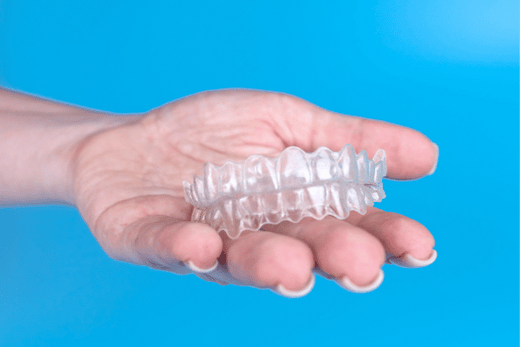
Tabla de contenido
Una mujer sosteniendo bandejas de alineadores transparentes
Introducción
La maloclusión, una desalineación de los dientes o una relación incorrecta entre los dientes de las dos arcadas dentales, es un problema dental frecuente que afecta a una parte importante de la población. Si bien los aparatos tradicionales han sido la solución preferida durante muchos años, existe una tendencia creciente a recomendar métodos invisibles para enderezar los dientes. En este artículo, analizaremos en profundidad las razones por las que los aparatos transparentes se están convirtiendo en la opción preferida para abordar la maloclusión.
1. Estética y confianza
Una de las principales razones por las que las personas optan por la alineación dental invisible es la ventaja estética que ofrece en comparación con los aparatos tradicionales. A diferencia de los brackets y alambres metálicos visibles, los alineadores invisibles son prácticamente indetectables, lo que permite a las personas someterse a un tratamiento de ortodoncia sin sentirse cohibidas. Este beneficio estético contribuye significativamente a mejorar la confianza durante el proceso de tratamiento.
Según el Dr. Ather, ortodoncista autorizado en EE. UU., “la gente suele utilizar el término enderezamiento cosmético de dientes, que no es un término de ortodoncia; sin embargo, cuando se utilizan tratamientos para arreglar la dentadura, también puede ser estéticamente agradable”.
Descubra más sobre la alineación de los dientes en nuestro podcast.
https://www.youtube.com/watch?v=osX99mglEMw
2. Comodidad y conveniencia

La alineación invisible de los dientes implica el uso de alineadores transparentes hechos a medida que se pueden quitar. Esto no solo proporciona un mayor nivel de comodidad, sino que también ofrece una comodidad incomparable. A diferencia de los aparatos tradicionales, que pueden causar incomodidad y dificultad para limpiarlos, los alineadores invisibles se pueden quitar fácilmente para comer, cepillarse los dientes y usar hilo dental. Este factor de comodidad es particularmente atractivo para las personas con estilos de vida ajetreados.
"La alineación de los dientes no se trata sólo de crear una sonrisa perfecta; se trata de fomentar una armonía perfecta entre la salud bucal, la confianza y una persona radiante".
3. Resultados predecibles con tecnología avanzada
La tecnología detrás de la alineación invisible de los dientes ha avanzado significativamente en los últimos años. El diseño asistido por computadora (CAD) y la tecnología de impresión 3D se utilizan ahora para crear alineadores precisos y personalizados. Esto garantiza un resultado más preciso y predecible en términos de alineación de los dientes. Los pacientes pueden visualizar los resultados esperados antes de comenzar el tratamiento, lo que agrega una sensación de seguridad y transparencia al proceso.
4. Reducción del tiempo de tratamiento
La alineación invisible de los dientes suele dar como resultado un tiempo total de tratamiento más corto en comparación con los aparatos tradicionales. La duración del tratamiento varía de persona a persona, pero la tecnología innovadora utilizada en los alineadores invisibles puede acelerar el proceso de alineación de los dientes. Esto puede resultar especialmente atractivo para las personas que buscan una solución de ortodoncia más rápida.
5. Impacto mínimo en las actividades diarias
Los aparatos tradicionales pueden restringir ciertas actividades, como tocar instrumentos musicales o participar en deportes de contacto. Los alineadores invisibles, al ser extraíbles, permiten a las personas realizar sus actividades habituales sin interferencias significativas. Esta adaptabilidad hace que la alineación dental invisible sea una opción práctica para personas con diversos estilos de vida.
Conclusión
La alineación invisible de los dientes ha surgido como una solución contemporánea y eficaz para abordar la maloclusión. La combinación de atractivo estético, comodidad, tecnología avanzada, menor duración del tratamiento y mínimo impacto en las actividades diarias lo convierten en una opción atractiva para quienes buscan un tratamiento de ortodoncia. A medida que el campo de la odontología continúa evolucionando, es probable que la popularidad de la alineación invisible de los dientes crezca, brindando a las personas una forma discreta y eficiente de lograr una sonrisa bellamente alineada.
Transforme su sonrisa con Alignerco : su camino hacia una alineación dental discreta y eficaz. Descubra los beneficios de los alineadores invisibles adaptados a sus necesidades. ¡Dé el primer paso hacia una sonrisa segura hoy mismo!
Preguntas frecuentes
1. ¿Cualquier persona puede utilizar la alineación dental invisible o sólo es adecuada para casos específicos?
La alineación invisible de los dientes es adecuada para varios casos de maloclusión, pero la gravedad de la desalineación puede influir en las opciones de tratamiento. Lo mejor es consultar con un profesional de la ortodoncia para determinar si los alineadores invisibles son la opción adecuada para su situación específica.
2. ¿Cuánto tiempo suele durar el tratamiento con alineadores invisibles?
La duración del tratamiento con alineadores invisibles varía de persona a persona. En promedio, puede oscilar entre unos meses y un par de años, dependiendo de la complejidad de la maloclusión. Su ortodoncista le proporcionará un cronograma personalizado en función de sus necesidades individuales.
3. ¿Son los alineadores invisibles tan efectivos como los brackets tradicionales para corregir la maloclusión?
Sí, los alineadores invisibles son muy eficaces para corregir la maloclusión. La tecnología utilizada en estos alineadores, que incluye CAD e impresión 3D, garantiza planes de tratamiento precisos y personalizados. Sin embargo, la eficacia puede depender del compromiso de la persona de usar los alineadores según las instrucciones.
4. ¿Con qué frecuencia debo usar los alineadores invisibles cada día?
Para obtener resultados óptimos, se recomienda usar alineadores invisibles entre 20 y 22 horas al día. Solo se deben quitar para comer, beber (excepto agua), cepillarse los dientes y usar hilo dental. El uso constante es fundamental para garantizar que el tratamiento avance según lo planeado.
5. ¿Está incluida la supervisión profesional en los tratamientos con alineadores en casa?
Los alineadores invisibles están diseñados para ser removibles, lo que le permite comer y hablar cómodamente sin interferencias. Si bien puede haber un período de ajuste inicial, la mayoría de las personas se adaptan rápidamente a los alineadores. Es importante seguir las pautas proporcionadas por su ortodoncista para garantizar una integración perfecta en su rutina diaria.


